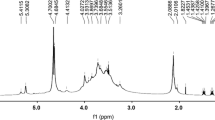Abstract
Oxidative stress and the resulting damage to cellular and extracellular components has been observed in a variety of degenerative processes, including degenerative joint disorders, where high-molar-mass hyaluronan (HA) is often found to be massively degraded. The present study sought to test the hypothesis that dithiols are more effective in protecting biomacromolecules from free-radicalmediated damage than monothiols. The materials/thiols tested included bucillamine (BUC), dithioerythritol (DTE), dithiothreitol (DTT) and glutathione (GSH), as a reference, for their effectiveness in protecting HA from oxidative degradation induced in vitro. Since HA degradation results in a decrease in its dynamic viscosity, rotational viscometry was applied to follow HA oxidative degradation. The free-radical-scavenging activities of the thiols tested were determined by 2,2′-azino-bis(3-ethylbenzthiazoline-6-sulphonic acid) (ABTS) and di(phenyl)-(2,4,6-trinitrophenyl)iminoazanium (DPPH) assays. It was found that all the dithiols in the concentration range tested protected HA from the oxidative degradation. On the other hand, monothiol GSH exerted protection only at high concentrations (10 μmol L−1 and 100 μmol L−1) and 1 μmol L−1 of GSH even exhibited a prodegradative effect. The ABTS assay revealed free-radical scavenging activities in the following order: BUC, DTT, DTE, GSH, and that of the DPPH assay: BUC, DTE, DTT, GSH. In conclusion, it was demonstrated that dithiols may be more effective than monothiols in affording biomacromolecule protection from oxidative degradation.
Similar content being viewed by others
References
Afonso, V., Champy, R., Mitrovic, D., Collin, P., & Lomri, A. (2007). Reactive oxygen species and superoxide dismutases: Role in joint diseases. Joint Bone Spine, 74, 324–329. DOI: 10.1016/j.jbspin.2007.02.002.
Apak, R., Gorinstein, S., Böhm, V., Schaich, K. M., Özyürek, M., & Güçlü, K. (2013). Methods of measurement and evaluation of natural antioxidant capacity/activity (IUPAC Technical Report). Pure and Applied Chemistry, 85, 957–998. DOI: 10.1351/pac-rep-12-07-15.
Buettner, G. R., & Schafer, F. Q. (2002). Ascorbate (vitamin C), its antioxidant chemistry. The virtual free radicalzschool for oxygen society. Retreived March, 22, 2014, from http://www.healthcare.uiowa.edu/corefacilities/esr/publications/buettnerpubs/pdf/Buettner-Ascorbate-Chemistry-1.pdf
Chang, J. Y. (1997). A two-stage mechanism for the reductive unfolding of disulfide-containing proteins. Journal of Biological Chemistry, 272, 69–75. DOI: 10.1074/jbc.272.1.69.
Cheng, Z. H., Moore, J., & Yu, L. L. (2006). High-throughput relative DPPH radical scavenging capacity assay. Journal of Agricultural and Food Chemistry, 54, 7429–7436. DOI: 10.1021/jf0611668.
Giles, G. I., Tasker, K. M., & Jacob, C. (2002). Oxidation of biological thiols by highly reactive disulfide-S-oxides. General Physiology and Biophysics, 21, 65–72.
Govindaraju, K., Govindaraju, V., & Eidelman, D. H. (2003). A analysis of glutathione in rat airway surface liquid by capillary zone electrophoresis with conductivity detection. Journal of Chromatography B, 788, 369–376. DOI: 10.1016/s1570-0232(03)00061-8.
Hrabárová, E., Gemeiner, P., & Šoltés, L. (2007). Peroxynitrite: in vivo and in vitro synthesis and oxidant degradative action on biological systems regarding biomolecular injury and in-flammatory processes. Chemical Papers, 61, 417–437. DOI: 10.2478/s11696-007-0058-8.
Kładna, A., Aboul-Enein, H. Y., Kruk, I., Michalska, T., & Lichszteld, K. (2006). Anti-oxidant and pro-oxidant behaviour of bucillamine. Luminescence, 21, 90–97. DOI: 10.1002/bio.890.
Lima, A. I. G., Corticeiro, S. C., & Figueira, E. M. A. P. (2006). Glutathione-mediated cadmium sequestration in Rhizobium leguminosarum. Enzyme and Microbial Technology, 39, 763–769. DOI: 10.1016/j.enzmictec.2005.12.009.
Magalhães, L.M., Segundo, M. A., Reis, S., & Lima, J. L. F. C. (2008). Methodological aspects about in vitro evaluation of antioxidant properties. Analytica Chimica Acta, 613, 1–19. DOI: 10.1016/j.aca.2008.02.047.
Mazor, D., Greenberg, L., Shamir, D., Meyerstein, D., & Meyerstein, N. (2006). Antioxidant properties of bucillamine: possible mode of action. Biochemical and Biophysical Research Communications, 349, 1171–1175. DOI: 10.1016/j.bbrc.2006.08.155.
Meyer, K., & Palmer, J. W. (1934). The polysaccharide of the vitreous humor. Journal of Biological Chemistry, 107, 629–634.
Moskaug, J., R. (2005). Polyphenols and glutathione synthesis regulation. American Journal of Clinical Nutrition, 81, 277S–283S.
Rahal, A., Kumar, A., Singh, V., Yadav, B., Tiwari, R., Chakraborty, S., & Dhama, K. (2014). Oxidative stress, prooxidants, and antioxidants: The interplay. BioMed Research International, 2014, 1–19. DOI: 10.1155/2014/761264.
Re, R., Pellegrini, N., Proteggente, A., Pannala, A., Yang, M., & Rice-Evans, C. (1999). Antioxidant activity applying an improved ABTS radical cation decolorization assay. Free Radical Biology and Medicine, 26, 1231–1237. DOI: 10.1016/s0891-5849(98)00315-3.
Scigelova, M., Green, P. S., Giannakopulos, A. E., Rodger, A., Crout, D. H. G., & Derrick, P. J. (2001). A practical protocol for the reduction of disulfide bonds in proteins prior to analysis by mass spectrometry. European Journal of Mass Spectrometry, 7, 29–34.
Šoltés, L., Stankovská, M., Brezová, V., Schiller, J., Arnhold, J., Kogan, G., & Gemeiner, P. (2006). Hyaluronan degradation by copper(II) chloride and ascorbate: rotational viscometric, EPR spin-trapping, and MALDI-TOF mass spectrometric investigations. Carbohydrate Research, 341, 2826–2834. DOI: 10.1016/j.carres.2006.09.019.
Valachová, K., Hrabárová, E., Dráfi, F., Juránek, I., Bauerová, K., Priesolová, E., Nagy, M., & Šoltés, L. (2010). Ascorbate and Cu(II)-induced oxidative degradation of high-molarmass hyaluronan. Pro- and antioxidative effects of some thiols. Neuroendocrinology Letters, 31, 101–104.
Ziouti, N., Triantaphyllidou, I. E., Assouti, M., Papageorgakopoulou, N., Kyriakopoulou, D., Anagnostides, S. T., & Vynios, D. H. (2004). Solid phase assays in glycoconjugate research: applications to the analysis of proteoglycans, glycosaminoglycans and metalloproteinases. Journal of Pharmaceutical and Biomedical Analysis, 34, 771–789. DOI: 10.1016/s0731-7085(03)00565-x.
Author information
Authors and Affiliations
Corresponding author
Rights and permissions
About this article
Cite this article
Baňasová, M., Valachová, K., Juránek, I. et al. Dithiols as more effective than monothiols in protecting biomacromolecules from free-radical-mediated damage: in vitro oxidative degradation of high-molar-mass hyaluronan. Chem. Pap. 68, 1428–1434 (2014). https://doi.org/10.2478/s11696-014-0591-1
Received:
Revised:
Accepted:
Published:
Issue Date:
DOI: https://doi.org/10.2478/s11696-014-0591-1




